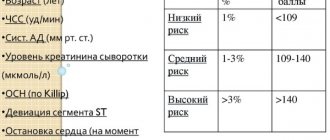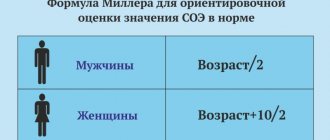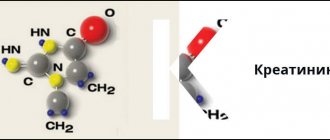Important Notes
Glomerular filtration rate is a very accurate and important test, so there are several other important nuances that must be taken into account when undergoing it.
- It is believed that in an adult after 40 years of age, creatinine clearance drops by 6.5 ml/min every 10 years of life. Therefore, a reduced rate for a young body will be considered normal for an elderly person.
- Drugs such as Cimetidine, Trimethoprim and ketonic acids significantly distort the normal result. This should be taken carefully, especially for those patients who have severe renal failure.
- In order for the analysis to be performed correctly, you must follow all recommendations. Determining the glomerular filtration rate is possible only if a person has collected all the urine that was excreted in one day. Missing even one urination may reduce the accuracy of the result.
Some features of GFR analysis
Because creatinine is released by muscles, external or internal conditions that affect the muscles will also affect GFR. People with muscle disease, obesity , amputations, or paralysis require alternative ways to determine glomerular filtration rate. Also, more accurate analysis is needed for young people (under 18 years of age) and pregnant women, as they experience changes in muscle mass, which can lead to an underestimation of GFR. []
To solve this problem, new formulas have been developed that link GFR to another marker of kidney function, cystatin C. Unlike creatinine, cystatin C can be found in almost all tissues of our body. Many studies have shown that the level of cystatin C in the blood is a more accurate indicator of kidney function than the level of creatinine. In addition, some formulas include cystatin C and creatinine, and this is the most accurate test of glomerular filtration rate to date. [, , , ]
Finally, there are special equations for calculating GFR in children that take into account the child's height. []
GFR norm
The kidneys are the body’s natural filter, through which metabolic products, including dangerous toxins, leave the body. In total, they can process up to 200 liters of liquid in 24 hours. After all harmful elements are removed from the water, it returns to the blood again.
Often, to diagnose the effective functioning of the kidneys, the determination of glomerular filtration rate is used, the norm of which is different for each person.
The main problem of the kidney is that under the influence of heavy stress, nephrons die.
As a result, it works worse and worse as a filter, since new elements will no longer be formed. As a result, a lot of different diseases and complications arise. People who drink alcohol, eat a lot of salty foods and have bad heredity are especially prone to this.
If, based on any symptoms, the doctor determines that the patient’s complaints are related to the kidneys, he may be prescribed a diagnostic method such as GFR, that is, determining the glomerular filtrate rate.
Read our article about how the human kidneys work.
In order to determine GFR, special formulas are used. There are several of them, and they differ in information content. But everywhere they use one term, namely clearance. This is an indicator by which you can determine how much blood plasma will be processed in one minute.
Normal values
Experts note that there is no clear standard for GFR, since each organism has individual indicators. However, there are certain boundaries for each age and gender:
- men - 125 ml/min;
- women - 110 ml/min;
- for children under 12 years old - 135 ml/min;
- in newborns - about 40 ml/min.
During normal operation of natural filters, the blood will be completely purified about 60 times a day. With age, the quality of kidney function deteriorates, and the intensity of filtration becomes less.
There are 3 main types of diseases that reduce or increase the filtration rate. Using this indicator, you can get a preliminary diagnosis, and additional tests will give a clearer picture.
The class of diseases that cause a decrease in the GFR rate include:
- Chronic kidney disease (see stages of CKD in the table). This disease leads to increased concentrations of urea and creatinine. In this case, the kidneys cannot cope with the load normally, which leads to the gradual death of nephrons, and then to a decrease in the filtration rate.
- About the same thing happens with pyelonephritis. This disease is infectious in nature. Pyelonephritis is characterized by inflammatory processes that necessarily affect the nephron tubules. This inevitably leads to a decrease in glomerular filtration rate.
- One of the most dangerous conditions can be considered hypotension. In this case, the disease is associated with very low blood pressure. All this can lead to heart failure and a decrease in GFR levels to critical levels.
The class of diseases that provoke increased kidney function includes:
- diabetes;
- high blood pressure (hypertension);
- lupus erythematosus, which also leads to increased stress on the kidneys.
How to calculate?
For this diagnostic method, one of the key roles is played by the speed of the filtration process. It is by this indicator that a dangerous disease can be diagnosed at an early stage. GFR does not give a complete picture, but it will certainly point you in the right direction in the search for an accurate diagnosis.
In order to calculate how much fluid the kidneys can process, volume and time data are used. Therefore, the final result will be displayed in ml/min. In addition, data on the amount of creatinine in urine is used. To do this, a special analysis is carried out, in which it is necessary to collect urine throughout the day.
Daily urine volumes are used to determine GFR. This way, specialists in the laboratory will be able to calculate the approximate volume of liquid per minute, which will be the filtration rate. Next, the indicators are checked against the norm.
GFR levels should be highest in children around 12 years of age. Then the indicators begin to decline. This becomes especially noticeable after the age of 55, when metabolic processes no longer occur so actively in the human body.
Glomerular filtration rate may depend on several factors:
- the volume of blood present in the body;
- pressure in the cardiovascular system;
- the condition of the kidneys themselves and the number of healthy nephrons also plays an important role.
If a person cares about his health, these indicators should be normal.
A healthy person has a relatively stable level of glomerular filtration rate, but it begins to decline after 40 years by one percent annually. There are also gender differences in indicators. The speed limit is not an exact value, as values vary slightly between laboratories.
GFR indicators, called normal:
- In women, the optimal values are considered to be from 70 to 130 ml/min.
- The norm for men is from 90 to 145 ml/min.
- GFR in children is almost independent of age. If in a one-year-old baby this figure is already on par with the indicators of adults - in the range from 80 to 130, then by puberty it remains the same. However, it is advisable to evaluate results according to standards only from the age of two years or older.
What formulas are used to calculate GFR?
In medicine, the value associated with creatinine clearance is most often used - this method is considered the simplest and most convenient for medical diagnosis. Since it is excreted through the glomeruli only by 85-90%, and the rest through the proximal tubules, calculations are carried out with an indication of the error.
The lower its value, the correspondingly higher the GFR rate. Direct measurement of insulin filtration rate is too expensive for medical diagnosis and is used mainly for scientific purposes.
The patient's blood and urine are used for the analysis. It is especially important to collect urine strictly within the allotted time period. Today there are 2 options for collecting material:
- Two hourly portions of urine are collected, and in each sample the minute diuresis and the concentration of the end product of protein breakdown are examined. The result is two GFR values.
- Less commonly used is the daily amount of urine, in which the average creatinine clearance is determined.
On a note! The situation with blood is simpler - in it the concentration of creatinine remains unchanged for a long time, so this sample is taken as standard - in the morning on an empty stomach.
Standard formula
(up x Vn) / (Ср x Т),
where Vn is the volume of urine over a fixed period of time, Cp is the concentration of creatinine in the blood serum, T is the time during which urine is collected in minutes.
Cockcroft-Gault formula
[(140 - (number of years) x (weight, kg)] / (72 x serum creatinine concentration, mg/dl)
The result of the calculation using this formula is true for an adult man; for women, the result must be multiplied by a coefficient of 0.85.
Criatinine clearance formula
[(9.8 - 0.8) x (age - 20)]/ serum creatinine concentration, mg/min
For women in this case, you also need to apply a coefficient of 0.9.
You can use one of the online calculators that will help you calculate your creatinine clearance. One of them can be found at this link.
Since GFR depends on the rate of clearance of creatinine from blood plasma, it is also calculated manually using the formula:
(urine creatinine concentration x urine volume over time)/(plasma creatinine concentration x urine collection time in minutes)
Factors that increase the risk of developing chronic kidney disease
- High blood pressure [, ]
- Diabetes mellitus type 1 and 2 [, ]
- Heart diseases []
- Obesity []
- Smoking [, ]
- Family history of kidney disease (genetics) []
- Age (60 years and above) []
- Previous kidney damage []
- Low birth weight [, ]
- Infections of the genitourinary system
- Increased blood cholesterol HDL below 40 mg/dL increase the risk of kidney disease by 2 times)
- Autoimmune diseases (eg, systemic lupus erythematosus)
- Staphylococcal infections (sore throats, pharyngitis)
- Sickle cell anemia
- Goodpasture's syndrome
- Hepatitis C
- Heart failure
- HIV
- Malignant tumors (development of paraneoplastic nephritis)
- Difficulty in urine flow
- Vesicoureteral (or vesicourethral) reflux is the reflux of urine from the bladder into the ureter.
- Worm infestations
- Gastrointestinal disorders (constipation, dysbacteriosis, malabsorption syndrome).
- Kidney tuberculosis
- Pyelonephritis
- Polycystic kidney disease
Factors distorting indicators
It is not difficult to guess that in order to obtain a reliable examination result, the patient must follow certain rules, which were indicated above. If he was negligent in complying with the laboratory’s requirements, then the indicators may differ significantly from the norm and the patient will be prescribed a new referral. For example, a low glomerular filtration rate can be detected if the biomaterial is poorly stored (warm place) or is not submitted for research on time.
In addition, the result may exceed the norm or be less than it if the patient was actively involved in sports the day before. Also, some medications can significantly distort the result, which will be an indication for re-examination. Among them:
- "Cimetidine";
- "Trimethoprim";
- "Quinidine" and others.
Do not forget that before undergoing such a serious analysis, you need to talk with a specialist about taking any medications.
In what cases is examination indicated?
As a rule, deviations in clearance indicators from the norm are detected randomly, for example, during routine examinations, but any qualified doctor can, based on external factors, determine whether a person has pathologies that are associated with the kidneys.
So, an analysis of the glomerular filtration rate of the kidneys is prescribed if the patient complains of pain in their area, and there is swelling in the face and ankles. Also, a similar study is indicated for hypertensive patients and people who experience rare urination. The analysis is necessary when dark urine or blood is found in it, in case of chronic insufficiency, Cushing's syndrome, diabetes mellitus. Creatinine in daily urine
| Floor | Normal indicators |
| men | 5.3-15.9 mmol/day |
| women | 7.1-17.7 mmol/day |
Clearance
| Floor | Normal values |
| men | 75-115 ml/min |
| women | 95-145 ml/min |
Of course, this is not the entire list of pathologies and symptoms when a clearance study is prescribed, but it is worth remembering that absolutely any disease of the kidneys and urinary system requires this analysis. You should not refuse such a procedure, because almost all diseases begin with a mild form and a person practically does not feel any deviations or disruptions in his body.
What diseases can be diagnosed
Analysis of the Reberg-Tareev test is used when various pathologies of the excretory system are suspected. If this figure is less than normal, this means massive death of nephrons. This process may indicate acute and chronic renal failure.
Since GFR can decrease not only due to damage to the structural units of the kidney, but also due to third-party factors, this phenomenon is also observed with hypotension, heart failure, prolonged vomiting and diarrhea, hypothyroidism, diabetes insipidus, as well as difficulty in the outflow of urine due to a tumor or inflammation in the urinary tract.
An increase in GFR is observed in idiopathic acute and chronic glomerulonephritis, diabetes mellitus, arterial hypertension, and some autoimmune diseases.
Normally, GFR values are constant, in the range of 80-120 ml/min, and only with age this figure can decrease for natural reasons. If these numbers decrease to 60 ml/min, this indicates renal failure.










